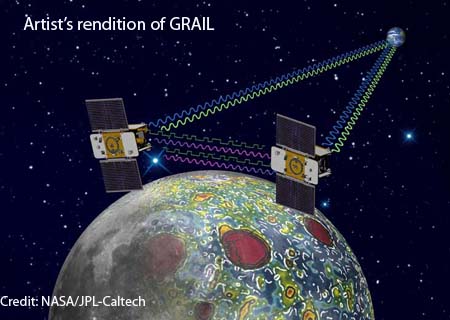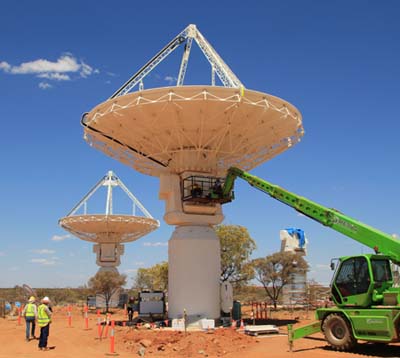|
Welcome to the first edition of the CSIRO Astronomy and Space Science (CASS) Education Newsletter for 2012. This year promises to be an exciting one in the field of astronomy with a decision expected for the siting of the SKA, the last transit of Venus this century and a total solar eclipse visible in Australia in November.
In this issue you'll find information about:
If you have any questions about CSIRO's astronomy education and outreach activities, please don't hesitate to contact me.
Robert Hollow
Education Officer
CSIRO Astronomy and Space Science
Come and spend three stimulating and rewarding days learning new approaches to astronomy teaching at the iconic Parkes Observatory. Astronomy from the Ground Up! is our annual teacher workshop for all science teachers o 18 - 20 May 2012. It targets the content and skills of junior Science syllabi from around Australia whilst also providing depth and enrichment for teachers of senior physics. Teachers tour the radio telescope, meet professional astronomers and have lectures on different aspects of astronomy including some of the latest discoveries.
Emphasis is placed on practical and hands-on activities to take back and use in the classroom. You will also explore the wonderful dark night skies with optical telescopes. Participants receive an extensive range of resources. The workshop also fulfils the requirements of the international Galileo Teacher Training Program (external link).
Dates: Friday 18 - Sunday 20 May 2012
Venue: CSIRO Parkes Observatory, Parkes NSW
Cost: $363 (GST incl) - includes materials, morning tea, lunches, dinners
Target audience: All Science teachers
Bookings: Essential.
For more details and registration please visit the workshop site.

Astrophysics for Physics Teachers workshop Marsfield, March 2012
This is a one-day workshop is presented by CASS Education Officer Rob Hollow and astronomers from CASS and AAO.
Date: Friday 30 March 2012
Time: 8.30 am - 4:00 pm
Venue: CSIRO Astronomy and Space Science Headquarters, cnr Vimiera and Pembroke Rds, Marsfield NSW
Cost: $132 (GST incl) - includes materials, morning tea, lunch and afternoon tea
Target audience: Teachers of HSC Physics and similar courses
Bookings: Essential.
For more details and registration please visit the workshop site.

STAV AIP Physics Teachers' Conference
CASS Education Officer Rob Hollow is presenting the following workshop session at the STAV AIP Physics Teachers Conference at Monash University, Friday 17 February:
What’s Up? Recent Astronomical Discoveries & Projects
Astronomy in a lively field of research with a wealth of new discoveries. In this presentation Rob will discuss key recent work in astronomy and astrophysics and how you can use this in the curriculum. Emphasis is placed on Australia’s involvement in the field and will include the 2011 Nobel Prize in Physics and new telescopes including the Australian SKA Pathfinder and the Square Kilometre Array.
This session is run as session A2 at 10.05am and repeated as B2 at 11.50am. There will also be several other astronomy-related workshop presentations by other presenters including teachers who have been to CASS teacher workshops (B7, C9) and collaborators from VSSEC (C13, D6) and the opportunity to visit VSSEC on Saturday 18 February.
More details and online registration.

To support Physics Teachers, STANSW will be holding a professional learning day on Physics Teaching and three follow up meetings.The professional learning day at the Powerhouse Museum in Sydney on Monday 12 March.
CASS Education Officer Rob Hollow will be presenting a keynote session on teaching astronomy and astrophysics at the day.
For more details and registration visit the STANSW Physics Network site.

Teaching Astronomy & Astrophysics Teacher Workshop, Scienceworks, Melbourne
VSSEC and the Melbourne Planetarium have joined with CSIRO Astronomy and Space Science to offer a teacher professional learning program which explores resources for teaching astronomy & astrophysics, and programs offered by the participating organisations.
- Date: Thursday May 3rd, 2012 Time: 9.30am – 4.30pm
- Venue: Scienceworks Museum, 2 Booker St, Spotswood, Victoria
- Cost: $100 plus GST (Total Cost :$110) (this includes cost of materials, and catering)
For more details and bookings visit the VSSEC Teacher Professional Learning site.

The Canberra Deep Space Communication Complex (CDSCC), managed by CSIRO as part of NASA’s Deep Space Network provides vital two-way radio contact with dozens of spacecraft exploring the Solar System and beyond.
The latest of these robotic missions is NASA’s twin GRAIL spacecraft which arrived at the Moon on January 1st and 2nd, 2012. By gravity mapping the Moon, GRAIL will help scientists to learn more about its internal structure and discover how our celestial neighbour formed billions of years ago.
While, the two spacecraft orbit the Moon to map its interior, a set of unique cameras will be taking images of the lunar surface – and students are invited to be the directors of photography.

The GRAIL MoonKAM (Moon Knowledge Acquired by Middle school students) will begin in early 2012. MoonKAM is designed to engage students in Years 5-8 in the GRAIL mission and lunar exploration. Students will select target areas on the lunar surface and send requests to the GRAIL MoonKAM Mission Operations Center (MOC). Photos of the target areas will be sent back by the GRAIL satellites and made available to the students through its web site. Students will use the images to study lunar features such as craters, highlands, and maria while also learning about future landing sites.
Students and teachers from around the world are invited to register at the mission web site. Best of all, you get to report your lunar discoveries directly to NASA scientists as you help us to explore the Moon.

PULSE@Parkes celebrated 50 observing sessions and four years of operation in December 2011. You may apply online to register your interest and be informed as soon as new dates are announced for sessions in April through September.
We currently have a vacancy for a school with a small class of about a dozen students or less for the observing session on 1 March. Another school with 5 students is already booked in for this so it would be a combined session. Register online or email me direct as soon as possible if interested.
January's school holiday session for members of CSIRO's Double Helix Science Club was a new initiative and a great success.
Don't forget, you can follow along with any observing session via our twitter feed; @PULSEatParkes and can now view a live data feed and webcam views from Parkes during an observing session.
Our next observing sessions are 11.00am - 1pm AEDT on Thursday 1 March and Tuesday 20 March.

ASKAP, or the Australian Square Kilometre Array Pathfinder, is CSIRO's new radio telescope currently under construction at the Murchison Radio-astronomy Observatory (MRO) in the Mid West region of Western Australia. It will comprise of 36 identical antennas, each 12 metres in diameter, working together as a single instrument. Incorporating novel receiver technologies and leading-edge ICT systems. ASKAP will be one of the world’s premier radio telescopes and will help to answer fundamental questions about our Universe.

- What does ASKAP look like right now? See the latest webcam images of ASKAP from the Murchison Radio-astronomy Observatory.
- Fly over the MRO with ASKAP Live to see the construction progress of ASKAP
- Great Progress for ASKAP in 2011 is a useful summary by Project Director Dr Antony Schinkel of the progress on the project for the last year.
- ASKAP project pages on the CASS web site. contains all the above and much more information.

CSIRO Education Regional Centres run hands-on workshops and shows about a diverse range science topics, including astronomy and space exploration. Our workshops are curriculum-based, and can come to your school (Labs on Legs) or can be run at our centres. We also offer teachers professional development, educational partnerships between schools and professional scientists, and other resources such as the free Science by Email. Schools can subscribe to our magazines, Scientriffic and The Helix and receive a teacher’s guide with every issue.
Visit the CSIRO Education Regional Centres page to find out what your Regional Centre offers.

New SKA Education Resources
The National Science-Technology Roadshow Trust in New Zealand has developed an extensive range of excellent education resources for teachers. Using the context of the Square Kilometre Array (SKA) they cover Science and Social Science topics ranging from Upper Primary to Upper Secondary level. Thirteen modules are currently available as PDFs.
The Window to the Universe teaching resource comprising 21 lessons for Years 9-10 developed a few years ago for Australian schools is freely available on the SKA.edu.au web site. The complete book or individual sections may be downloaded as PDFs.
You can also download The Square Kilometre Array Presenters Toolbox. This resource provides you with the building blocks to deliver an engaging presentation relating to the Square Kilometre Array (SKA) and a range of related topics. Keynote and Powerpoint versions are available, along with a users guide containing instructions and slide notes.

Australian Gemini School Astronomy Contest
Australian school students have a chance to use an hour of observing time on one of the world's largest optical telescopes, the 8-metre Gemini South telescope in the Andes Mountains of Chile.
How? By picking an object in the Southern sky and writing a winning explanation of why it would be interesting to digitally photograph. In one page, explain why your selected target would be a good choice to be imaged by the Gemini South Telescope. Justify your answer with reasons of scientific interest and visual appeal.
The contest is open to any Australian students in Years 5-12, as well as inter-school groups and clubs of students, provided each entry has a clearly designated submitting school and teacher. Entries may be written individually or in groups, but must be submitted by a teacher.
Entries must be received by Friday 11 May 2012.
For more details, submission form and resources visit the contest web site.

Globe at Night
More stars. Less light. Participate in GLOBE at Night!
Calling all Earthlings! Take a few minutes to get involved in the GLOBE at Night campaign to preserve dark skies! GLOBE at Night is a citizen-science campaign open to people all over the world to raise awareness of the impact of light pollution by inviting citizen-scientists to measure their night sky brightness and report their observations to a web site. from a computer or smart phone. Light pollution threatens not only our “right to starlight”, but can affect energy consumption, wildlife and health. Through 2011, people in 115 countries contributed 66,000 measurements, making GLOBE at Night one of the most successful light pollution awareness campaigns to date.
You can participate in the 2012 campaign an hour after sunset till about 10pm February 12 through 21, March 13 through 22, and April 11 through 20. For information and resources, visit www.globeatnight.org.

Astronomy News
2012 should prove an exciting year. We have the Transit of Venus in June, a total solar eclipse in November, both visible from Australia and the announcement of the site selection for the SKA expected in the first half of the year.
Transit of Venus
The last transit of Venus this century takes place on 6 June. The entire transit will be visible to observers in eastern states of Australia. Observers in Western Australia will be able to observe the transit already underway from sunrise. We will have more news about the transit in our Term 2 newsletter and will be featuring it in some of our CASS teacher workshop sessions over the next few months.
The Astronomical Society of Australia has produced an excellent fact sheet about the transit. It includes observing details, history and background plus other links. You can download this PDF and distribute freely for educational purposes. A useful site with a wealth of information and teaching resources about the transit is transitofvenus.org.

Your Subscription
You can update or delete your newsletter subscription details at any time by contacting robert.hollow@csiro.au
Please be assured that you will only receive CASS Education E-Newsletter and your email address won't be used for any other purpose.

|